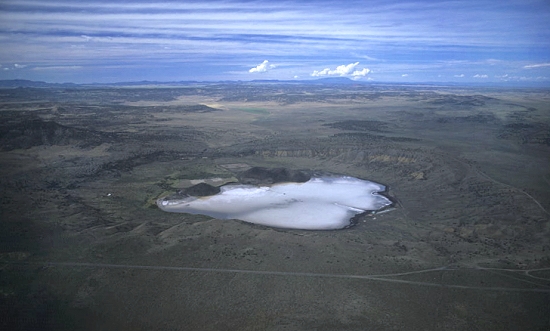The Salt Lake pilgrimage mural tells the story of two young Hopi men as they walk 230 miles round trip from their home to the Zuni mesas, passing through what is now Petrified Forest National Park, on a salt collecting journey. It was not only a physical journey; it was also a sacred journey. The salt is an important food preservative, flavoring and used for ceremonial purposes.
In addition to ceremonial pilgrimages, Hopis from all of the Hopi villages also made other journeys to Zuni Salt Lake to make ritual offerings if there was a drought and to collect salt for domestic purposes. On these trips to Zuni Salt Lake, Hopis often traveled via Zuni Pueblo, where they would stop to visit with friends and trade Hopi pottery, baskets, and textiles. Certain Hopi men through the centuries have also made pilgrimage to the Salt Mine near the Grand Canyon and their place of emergence into this the 4th world.
 |
| Fred Kabotie mural of Zuni Salt Lake Hopi pilgrimage |
The murals tie the ancestral Puebloan people of the region to the Hopi people of the 1940s and today. While Painted Desert Inn gained status as a National Historic Landmark primarily due to its architecture, the murals of Fred Kabotie made a significant impact on the nomination.
Zuni Salt Lake (in western New Mexico about 60 miles south of Zuni Pueblo) is still a sacred site today. For centuries, the Pueblo people of the Southwest, including the Zuni, Acomo, Laguna, Hopi and Taos pueblos, have made annual pilgrimages to Zuñi Salt Lake to harvest salt, for both culinary and ceremonial purposes.
The Lake and surrounding area (known as the Sanctuary Zone) are considered sacred ground by six Native American tribes--especially to the Zuni Tribe, who believe that it gives life to Ma'l Oyattsik'I, Salt Woman, one of the tribe's central deities.
Mineral springs from an extinct volcano bubble to the surface here laden with pure sodium chloride. Natural evaporation causes the salt to crystalize into a glittering crust on the lake's bed, where it is scooped up by the handful (gathered for consumption and ceremonial use) in exchange for a small cornmeal offering. A network of foot trails running east, north and west connects "Salt Woman" with every major pueblo and tribal village in the area. Zuni Tribal Council member David Wyaco, Sr. compares the trails to umbilical cords linking the villages to their source of life.
The Zuni Salt Lake was not part of the Zuñi reservation originally recognized by the U.S. government. In 1978, An Act of Congress provided for the return of the Zuni Salt Lake to the Zuni Tribe and allowed the Zunis to sue the government for lands taken without payment. The U.S. returned the lake itself, and 5,000 acres surrounding it (Sanctuary Zone), to Zuni control in 1985. In recognition of the sites' significance, the National Park Service listed Zuni Salt Like on the National Register of Historic Places in 1999.
 |
| Zuni Salt Lake from National Trust for Historic Preservation |
In 2003, the site was threatened by a proposed coal mine (to make electricity for Phoenix) that would have drawn water from the aquifer underlying the lake and placed construction on federal lands between the lake and Zuni Pueblo. Zuni Salt Lake received a reprieve when the mine company withdrew its application and relinquished its interests in the area after several lawsuits.
That same year, another threat arose when the Bureau of Land Management issued oil and gas leases across thousands of acres in the Sanctuary Zone. The National Trust for Historic Preservation challenged the leases and, in 2006, the Interior Board of Land Appeals overturned the leasing decision.
More recently, the National Trust recommended that BLM designate the entire Sanctuary Zone as an Area of Critical Environmental Concern (ACEC), a designation that would have prohibited oil and gas leasing and restricted groundwater pumping in the area. BLM ultimately decided to designate one-fourth of the Sanctuary Zone as an ACEC and agreed to develop a Memorandum of Understanding with Zuni and other tribes to establish a process for how BLM will consult with the tribes on actions proposed within the ACEC.












